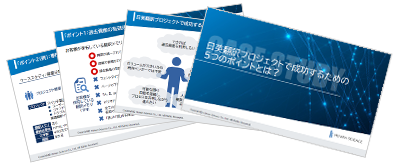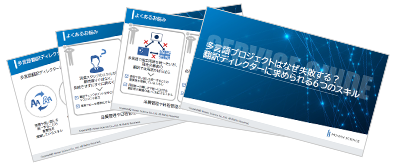
In the manufacturing (FA) and IT sectors, when expanding Japanese technical documents and user manuals into multiple languages, it is common to first translate from Japanese to English, and then translate into other languages based on the English version. An important aspect of this process is accurately reflecting the characteristics and nuances of Japanese expressions in English. If the English translation is unclear, or if the grammar and structure are complex and difficult to read, it can lead to misunderstandings and confusion in the subsequent translation stages.
This time, we will focus on five key points to pay special attention to during the Japanese-English translation process, aimed at those considering multilingual expansion, in order to prevent misunderstandings.
- Table of Contents
1. Appropriately supplement the omitted content in the translation
Technical documents in Japanese often contain abbreviated expressions. It is important to intentionally supplement these during translation. By clarifying the omitted parts, translation accuracy improves, and multilingual translation becomes smoother. Additionally, clarifying context and implicit assumptions can help prevent misunderstandings.
Example 1
| Source | When the error is cleared, it will be hidden. |
|---|---|
| Translation (Before Revision) | When the error is canceled, non-display is applied. |
| Translated Text (After Revision) | When the error is canceled, the icon is no longer displayed. |
In the revised translation, "will be hidden" has been specified as "the icon will no longer be displayed." This appropriately supplements the information about the "icon" that was omitted in the original text, preventing misunderstandings and the generation of unnatural translations in multilingual deployment.
Example 2
| Source | When using for planning clinical trials, please display the outline on the device used for planning and confirm that it is correct before use. |
|---|---|
| Translation (Before Revision) | Before applying this information in clinical trial planning, display the contours on the device that creates the plans and confirm whether it is correct. |
| Translated Text (After Revision) | Before applying this information in diagnosis planning, display the contours on the device that creates the plans and confirm that the information is correct. |
In the revised translation, "will be hidden" has been specified as "the icon will no longer be displayed." This appropriately supplements the information about the "icon" that was omitted in the original text, preventing misunderstandings and the generation of unnatural translations in multilingual deployment.
Example 3
| Source | If you want to restart the shooting after pressing the SET switch, please press the SET switch again to release it. |
|---|---|
| Translation (Before Revision) | To readjust radiography after pressing the SET switch, press the SET switch again to cancel. |
| Translated Text (After Revision) | To readjust radiography after pressing the SET switch, press the SET switch again to cancel the status. |
In the revised translation, the part "release it" has been specified as "please release (that) state". By supplementing the omitted "state" from the original text, the translation becomes clearer.
2. Break long sentences into shorter ones to make the translation easier to read
Japanese documents tend to be lengthy, often containing multiple pieces of information in a single sentence. Translating this directly into English can sometimes make it difficult to read. By appropriately splitting the sentences, the translated text becomes easier to read and understand. This approach helps avoid mistranslations and confusion, while also improving the accuracy of multilingual translations.
Example 1
| Source | Equipped with a main chain for suspension and a secondary wire, it has a fall prevention mechanism that supports in case the main chain breaks. |
|---|---|
| Translation (Before Revision) | The device is equipped with a fall prevention mechanism composed of a main chain and sub wire for suspension, and is supported by the sub wire even if the main chain breaks. |
| Translated Text (After Revision) | The device is equipped with a fall prevention mechanism composed of a main chain and sub wire for suspension. Even if the main chain breaks, the device is supported by the sub wire. |
The original text states, "(This device) is equipped with a main chain for suspension and a secondary wire" and "it has a fall prevention mechanism that supports in case the main chain breaks," which are combined into one sentence. In the revised translation, separating them into two sentences makes each piece of information easier to understand independently, improving readability.
Example 2
| Source | By pressing the [NUM-EN] key once as shown in the next figure, the [NUM-EN] key will be activated, allowing for numeric input via the numeric keypad. |
|---|---|
| Translation (Before Revision) | Pressing the [NUM-EN] key shown in the figure below once enables the [NUM-EN] key, which then enables numbers to be entered using the numeric keypad. |
| Translated Text (After Revision) | Press the [NUM-EN] key shown in the figure below once to enable the [NUM-EN] key. Numbers can now be entered using the numeric keypad. |
Using 'which' in a structure is grammatically correct, but for some readers, it can make the referent of 'which' unclear, leading to difficulty in reading. Therefore, it is recommended to improve readability by splitting the sentence into two.
Example 3
| Source | The equipment is delivered after sufficient adjustments have been made, so please do not touch the fixed adjustment parts. |
|---|---|
| Translation (Before Revision) | As the system is fully adjusted before delivery, do not touch the fixed adjustment areas. |
| Translated Text (After Revision) | The system is fully adjusted before delivery. Do not touch the fixed adjustment areas. |
In Japanese, constructions such as subordinate clause + main clause, like "~ so, please ~" are often used, but it is not always necessary to maintain the same structure when translating into English. By translating the two pieces of information, "The device will be delivered after it has been properly adjusted" and "Please do not touch the fixed adjustment parts" as separate sentences, the text becomes easier to read.
3. Avoid literal translation
When performing a literal translation from Japanese to English, careful handling is required as translators may become confused during multilingual deployment. Here, we will introduce some specific examples.
Example 1
| Source | Turning the Scale-Focus rotary encoder to the left will return to the ADV Scale. |
|---|---|
| Translation (Before Revision) | To return to ADV Scale, turn the Scale-Focus rotary encoder to the left. |
| Translated Text (After Revision) | To return to ADV Scale, turn the Scale-Focus rotary encoder counterclockwise. |
In the revised translation, "turn left" has been specified as "counterclockwise." Indeed, the original text states "if you turn to the left," which would directly translate to "turn ... to the left," but by using "counterclockwise," a clearer instruction appropriate for the operation is provided, preventing misunderstandings.
Example 2
| Source | Hover over the performance graph flag. |
|---|---|
| Translation (Before Revision) | Mouse over the collection flag. |
| Translated Text (After Revision) | Hover the mouse cursor over the collection flag. |
In the revised translation, the Japanese-English term "mouse over" was specifically translated as "Hover the mouse cursor over." If we simply translate the Japanese-English term "mouse over" as "mouse over," there is a risk that the translator may not understand its meaning, so it is necessary to use a clearer and more common expression.
Example 3
| Source | Disable Crossline Cursor to align with one of the measurement points. |
|---|---|
| Translation (Before Revision) | Put the cross-line cursor on the measurement point you wish to unlock. |
| Translated Text (After Revision) | Put the cross-hair cursor on the measurement point you wish to unlock. |
In the revised translation, I changed "cross-line cursor" to "cross-hair cursor." It is common to translate the katakana "cross-line cursor" directly as "cross-line cursor," but in English, it is expressed as "cross-hair cursor." Therefore, it is important to be careful as katakana expressions may differ in English.
4. Avoid unnecessary formal subjects and pronouns
Having too many unnecessary formal subjects and pronouns makes the text verbose and ambiguous. To maintain translation quality, it is important to strive for concise and clear expressions, directly indicating the subject and action.
Example 1
| Source | There are two ways to copy the RL preset. |
|---|---|
| Translation (Before Revision) | There are two methods on how to copy RL presets. |
| Translated Text (After Revision) | Two methods are available for copying RL presets. |
In the revised translation, the unnecessary formal subject "There" has been avoided, and the subject has been brought to the front to create an SVO structure. This makes the translation more concise and clear, allowing the information to be conveyed directly.
Example 2
| Source | You can use it by enabling the QL preset. |
|---|---|
| Translation (Before Revision) | QL presets can be used by enabling them. or By enabling QL presets, they can be used. |
| Translated Text (After Revision) | Enable QL presets for use. |
In the revised translation, unnecessary pronouns such as "them" and "they" have been avoided. Care should be taken when using pronouns, as they can make the appearance of the sentence worse and may lead to ambiguity regarding the subject.
Example 3
| Source | The Mch-i software login is required during the first startup of the external PC. |
|---|---|
| Translation (Before Revision) | When starting the external PC for the first time, it is necessary to log into the Mch-i software. |
| Translated Text (After Revision) | When starting the external PC for the first time, logging in to the Mch-i software is required. |
In the revised translation, the unnecessary formal subject 'it' was removed, and an SVO structure was used.
5. Correct irregular formats and notations
In Japanese-English translation with a view to multilingual deployment, it is important to appropriately modify the unique format of the Japanese original text. For example, irregular double quotation marks and abbreviations that are frequently seen in Japanese can lead to misunderstandings after translation. It is essential to correct these to a unified format and accurately convey the intent of the original text.
Example 1
| Source | Do not use devices that emit radio waves, such as "mobile phones", "walkie-talkies", "portable radios", "remote-controlled toys", near this equipment. |
|---|---|
| Translation (Before Revision) | Never use “cell phones”, “transceivers”, “walkie-talkies”, “radio controlled toys”, or other devices that emit radio waves near this device. |
| Translated Text (After Revision) | Never use cell phones, transceivers, walkie-talkies, radio controlled toys, or other devices that emit radio waves near this device. |
In the revised translation, double quotation marks have been removed. In Japanese, double quotation marks are sometimes used even for proper nouns or non-UI elements, but reflecting them directly in the English translation can lead to confusion for translators during multilingual translation deployment, increasing the risk of inquiries and mistranslations. Therefore, it is important to address this appropriately at the Japanese-English translation stage.
Example 2
| Source | Interval refers to the number of mm between slices. |
|---|---|
| Translation (Before Revision) | The interval means the number of millimeters between each slice that is cut out. |
| Translated Text (After Revision) | The “interval” means the number of millimeters between each slice that is cut out. |
In the revised translation, "interval" is indicated as "interval". This sentence is an explanation of the term, and enclosing "interval" in double quotation marks makes the meaning clearer.
Example 3
| Source | MC Please execute items 1-2-14 to 1-2-16 to transfer files to MC. |
|---|---|
| Translation (Before Revision) | To transfer files to an MC, perform items 2-5-18 through 2-8-20. |
| Translated Text (After Revision) | To transfer files to a memory card, perform items 2-5-18 through 2-8-20. |
In the revised translation, "MC" has been specified as "memory card." Properly addressing such abbreviations is an important point when considering Japanese-English translation for multilingual deployment.
6. Summary
In Japanese-English translation considering multilingual deployment, it is important to appropriately reflect the characteristics and expressions of the Japanese language in English. By paying attention to complementing omitted content, splitting long sentences, and avoiding literal translation, the quality of the translation can be improved, preventing misunderstandings and confusion. This makes the translation clearer and more user-friendly, enabling a smoother deployment in subsequent multilingual translations.
Human Science offers human translation services and post-editing services. We are a translation company that handles translations in a wide range of fields including software, manufacturing, IT, automotive, and distribution. Since 1994, we have been assisting many companies with their translation needs. If you have any concerns like the ones below, please feel free to consult us.
・Translation takes too long!
・Quality is poor and there are many complaints!
・Translation costs are too high!
・Many issues are caused by the Japanese manual!
・Unfamiliar with overseas laws and standards!
Related Services
Post-editing Agency and Operational Support Services



























